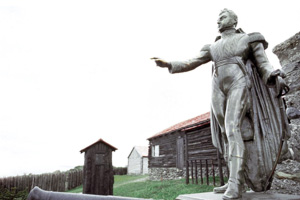After the war against the Peru-Bolivian Confederation was over, Prieto started to prepare the atmosphere for the presidential elections. The candidates were the generals Francisco Antonio Pinto, Joaquin Tocornal and Manuel Bulnes. The latter was the winner and he assumed the position on September 18th of 1841.
During his government (2 consecutive terms between 1841 and 1851) the republican regime was completely consolidated, because Spain recognized the independence of our country (1844) and also because of the influence and prestige that achieved after its victory in the war.
One of the first actions that he took in his position was to ask to the minister of the interior, Ramon Irarrazabal, to pass an amnesty law (October 23rd of 1841), through which Ramon Freire was pardoned and was incorporated to the officials who were discharged after the battle of Lircay. In addition, lifetime pensions were granted to Bernardo O’Higgins and José de San Martín.
In the economy, the minister of the portfolio, Manuel Rengifo, came to an agreement with the Londoner creditors in regards to the owed debt.
This allowed Chile to have economical stability and credibility before the foreigner investors.
In 1842, the minister of Public Instruction (education), Manuel Montt, commended to the Venezuelan Andres Bello the creation of the Universidad de Chile. Also in that year, the Normal School was founded, which formed basic instruction teachers. Two years later, the Navy School was reestablished. In 1849, the Academy of Fine Arts, the School of Architecture and the School of Art and Crafts were founded, where carpentry, blacksmith, foundry and mechanical shops were taught.
The following year, it opened its doors to the National Conservatory of Music.
Extension of the Sovereignty
One of the most important preoccupations for Bulnes was to define the boundaries of the Chilean territory.
While the Constitution of 1833 established that Chile was extended between the desert of Atacama and Cape Horn, the zone being occupied started in La Serena and ended in Concepcion, with some mining colonies in Copiapo and the towns of Valdivia and Chiloe.
Facing the possibility of having France or England taking over the Strait of Magellan, the president ordered the building of the Bulnes Fort (October 30th of 1843), thus establishing the sovereignty of Chile on that austral territory.
On the other hand, in the north zone of the country, near the Loa lake, a society of Chilean and foreigner investors started to exploit saltpeter and guano. Bolivia intervened, claiming the right of ownership, but Bulnes responded to this by sending a war ship that occupied Mejillones. During the next 20 years, Bolivia continued claiming the zone, until the resolving of the situation with the War of the Pacific.
Second term of Bulnes
After the reelection, there was a change of cabinet. Bulnes designated his cousin Manuel Camilo Vial as the new minister of the Interior and Finance. The latter entrusted the ministry of Justice to Salvador Sanfuentes, and the ministry of War and Navy, to the general Jose Manuel Borgoño.
In regards of public works, the Palacio de La Moneda was repaired (1846), the Penitentiary of Santiago was edified (1847) and a new building for the National Institute was built (1850).
In 1851, the Valparaiso Fire Department was created, an institution that later would be in Santiago and other cities of Chile.
After the enacting of the Colonization law (1845), which gave authorization to the establishment of colonies to the south of the Bio-Bio lake, the government named in 1949 to Vicente Perez Rosales as the agent of colonization in Valdivia. Upon his arrival, near to what is known today as the Chacao channel, to the south of Valdivia (1850), he established the first groups of immigrants, carried out explorations and mapped out planes to find the territories for the arriving colonies.
Military Mutiny
At the end of the presidency, Bulnes had to suffocate some disorders provoked by the Equality Society. These manifestations became revolutionary acts. One of the most known was the coup of state on April 20th of 1851 or the uprising of the regime of Valdivia, headed by the general Pedro Urriola.
Bulnes, aware of the situation, sent the loyal troops and the civic bodies. These forces had a hard combat at the foot of the Santa Lucia Hill, resulting in their victory after the death of Urriola due to a bullet that came from a police officer.








 Muere Evita
Muere Evita